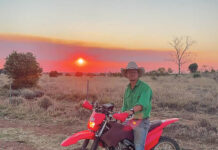SALEM, Ohio — Federal agencies continue to slog upstream through the murky legal and regulatory deluge surrounding a key component of the Clean Water Act as they work to clarify language used in the law governing water pollution once and for all.
Just what is Waters of the United States, or WOTUS, referring to, anyway?
Speaking before industry and agricultural-specific stakeholders during a listening session held May 1, senior EPA and U.S. Army Corps of Engineers officials highlighted legal milestones, the unanswered questions remaining around federal waterways and what they hope to achieve with a renewed push for stakeholder engagement in future rulemaking.
EPA Deputy Director Stacy Jensen emphasized the need for a clear, simple and enduring definition of “Waters of the United States,” urging a focus on practical implementation.
“We need to define this once and for all, standing the test of time,” she said, stressing that regulatory clarity must be matched by real-world applicability, and that rules are only effective if they can be carried out reliably in the field.
Background
The EPA and Army Corps of Engineers have proposed several new definitions of WOTUS since the 1970s, with significant implications for farmers, industry and the environment. Their evolving interpretations over time have influenced regulation enforcement across a variety of fields, from pollutant discharge permitting and wetlands preservation to oil spill cleanup, all of which are governed by the Clean Water Act.
A major turning point came in 2023, when the Supreme Court sharply narrowed the scope of federal authority under the Clean Water Act. In Sackett v. EPA, the court held that federal protection extends to wetlands only if they possess an uninterrupted surface connection with other water bodies that are already considered “waters of the United States,” significantly narrowing the law’s reach and reducing federal oversight of many isolated or intermittently connected wetlands.
As for where things stand now, it’s a bit of a toss up. In the aftermath of the Sackett decision, the EPA and Army Corps issued a new WOTUS rule that eliminated the “significant nexus” standard for determining whether wetlands were “Waters of the United States.” That new rule is in effect in roughly half the states, D.C. and territories while the pre-2015 definition — encompassing a broader range of water bodies — is still on the books everywhere else because of ongoing litigation.
A functional system
Participants in the listening session included farm bureau representatives, ranchers, real estate experts, tourism industry professionals and field scientists on the front lines of environmental permitting. They urged the EPA to simplify WOTUS standards, explicitly omit features such as ditches and intermittent streams, and trust landowners to manage their water. Many criticized the existing regulatory culture as burdensome and unpredictable, with others pushing agency officials to see firsthand how WOTUS requirements affect working lands across the country.
Courtney Briggs, senior director of government affairs for the American Farm Bureau Federation, called for clear, enforceable exemptions in the WOTUS rule and the removal of all ditches from federal jurisdiction, including upland cut ditches used to manage field runoff.
“Farm fields are made up of complex networks of ditches and water conveyances and control features that are necessary in order to support growing crops and raising animals,” she explained.
Environmental scientist Mallory Tatum emphasized the gap between legal definitions and practical application, noting that ambiguous terms like “relatively permanent” don’t translate well in the field.
“The current definition of Waters of the United States and how it’s being implemented is not working in the real world,” she said. “Regulation, when done right, benefits everyone… But when the rules are unpredictable or differ depending on who you ask or where you are, the system collapses.”
Representing the livestock industry, Idaho cattle producer and National Cattlemen’s Beef Association Vice President Kim Brackett urged agencies to develop a rule that landowners can understand and apply without technical experts.
“A practical WOTUS definition will allow the average landowner — not an engineer, not an attorney, not a wetland specialist — to walk out on their property, see a water feature and make at minimum a preliminary determination about whether a feature is federally jurisdictional,” she said. She warned that regulating ephemeral or isolated water bodies “stretches the agencies beyond its means” with little benefit to water quality.
For his part, Vincent Messerly, president of the Ohio-based Stream and Wetlands Foundation, emphasized the need for an efficient rulemaking process that aligns with Supreme Court decisions and provides clear guidance on terms like “continuous surface connection.” But he urged further action, saying clearer benchmarks could help resolve ongoing confusion.
The Stream and Wetlands Foundation helps developers follow environmental laws by restoring wetlands and streams through “mitigation banking,” a process that repairs damaged ecosystems in one area and sells credits to developers who impact nature elsewhere.
Some stakeholders argue that using clear, measurable standards like flow rate or watershed size rather than complex flow duration tests could bring more clarity to WOTUS regulations while still safeguarding vital water resources. In a follow-up conversation, Messerly highlighted the burden of using flow duration as a regulatory standard, noting that classifying streams as ephemeral, intermittent or perennial “sounds simple,” but documenting flow is a “Gordian knot.” Requiring landowners to monitor flow over extended periods, he said, is costly and impractical.
“Who has the time, the luxury, to stand back and wait six months, 12 months, 18 months, 24 months to get the data to confirm what type it is?” he asked.
Messerly pointed to a 180-page Army Corps of Engineers manual on flow regime determination as proof of the system’s complexity.
“It’s not something the average person is going to pick up and say, ‘Oh, yeah, I understand this.’”
That complexity often forces landowners to hire experts, driving up costs and causing delays, especially for individuals and small businesses. They often don’t realize they’re building on or near wetlands and have no idea they need special permits to do so. The process, Messerly estimated, could cost them at least $100,000 in fees, consultants and environmental offsets. For many, it’s a heartbreaking surprise.
Despite these challenges, Messerly expressed optimism, saying there is “potential certainly out there” for consensus. He encouraged stakeholders to consider tradeoffs in pursuit of a more functional system.
“Everybody wants to have clean air, clean water,” he said, but warned that the current process has everyone caught in a riptide of onerous regulations.
“We’re wasting a lot of time and energy arguing about things that really aren’t getting us any benefits to the environment. All it’s doing is paying attorneys and consultants a lot of fees, and causing a lot of time delays,” he said. Reallocating those resources, he believes, could lead to “a better quality environment than what we’re getting right now.”
A listening session to elicit additional feedback on vital components of the definition of WOTUS for local governments was held after press time from 3-5 p.m. on May 6, followed by additional public listening sessions to be announced soon. For more information about stakeholder engagement, visit online.










